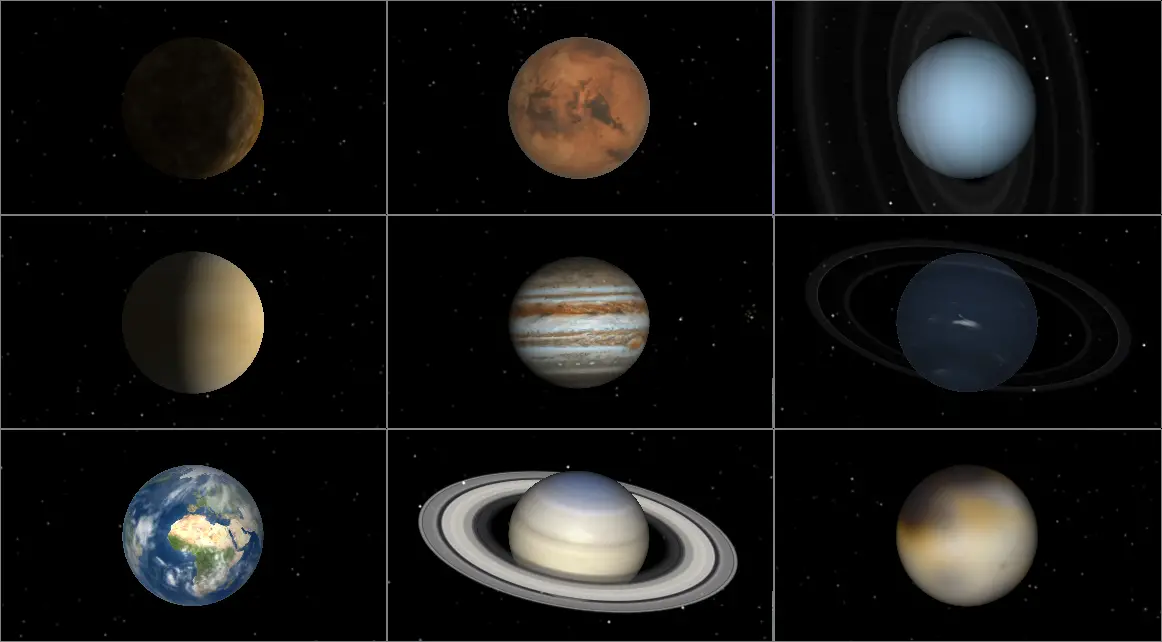The Solar System consists of the Sun and all the objects that orbit it, either directly or indirectly. Of these objects, there are currently nine known planets in our Solar System, plus many other smaller bodies that orbit the Sun itself. The four inner planets each have terrestrial surfaces and are composed primarily of rock and metal, while the four outer planets each have very large atmospheres and liquids made of various compounds that can be identified as organic or inorganic on Earth.
MERCURY
Mercury is our solar system’s innermost planet. Mercury is the minor planet in the solar system, revolving in only 88 days and slightly larger than Earth’s moon. Because Mercury is so close to the sun, its day and night temperatures are drastically different (approximately two-fifths the distance between Earth and the sun). Temperatures can reach a scorching 840 degrees Fahrenheit (450 degrees Celsius) throughout the day, which is hot enough to melt lead. At night, the temperature drops to – 290 degrees Fahrenheit (minus 180 C).
VENUS
The second planet from the sun, Venus, is roughly the same size as Earth. Radar scans collected beneath its atmosphere reveal a diverse range of mountains and volcanoes on the planet’s surface. Apart from that, the two planets are opposed. Because of its dense, lethal atmosphere of sulfuric acid clouds, Venus is an extreme example of the greenhouse effect. It’s scorching, much hotter than Mercury.
EARTH: THE PLANET WE CALL HOME, FULL OF LIFE
The ocean covers two-thirds of the surface of Earth, the third planet from the sun. It’s the only known world with life. Nitrogen and oxygen are abundant in the Earth’s atmosphere.
MARS
Mars is a freezing, dust-covered desert that orbits the sun as the fourth planet from the sun. This dust is made primarily of iron oxides, which gives the planet its unique red hue. Mountains, valleys, canyons, and storm systems ranging from small tornado-like dust devils to planet-engulfing dust storms dot the landscape of Mars.
JUPITER: OUR SOLAR SYSTEM’S LARGEST PLANET
According to NASA, Jupiter, the fifth planet from the sun, is a colossal gas giant and the most massive planet in our solar system, weighing more than twice as much as all the other planets combined. It has a rainbow appearance due to the different types of trace gases in its swirling clouds.
SATURN: THE SOLAR SYSTEM’S RINGED JEWEL
Saturn’s rings are the most well-known feature of the sixth planet from the sun. Galileo Galilei thought Saturn was a three-part entity with a planet on one side and two massive moons on the other when he first saw it in the early 1600s.
IN OUR SOLAR SYSTEM, URANUS IS THE TILTED, SIDEWAYS PLANET.
Uranus, the sun’s seventh planet, is a weird planet. It contains hydrogen sulfide clouds, which are the same substance that gives rotten eggs their foul stench. Like Venus, it spins from east to west. Unlike that of any other planet, the equator of Venus is roughly perpendicular to its orbit — it orbits on its side.
A GIANT, STORMY BLUE PLANET, NEPTUNE
Neptune, the eighth planet from the sun, has solid supersonic winds and is almost the same size as Uranus. Neptune is a cold and distant planet. Earth is 30 times farther distant from the sun than the planet.
PLUTO: ONCE A PLANET, NOW A DWARF PLANET PLUTO
In many ways, Pluto, originally the ninth planet from the sun, is unlike any other planet. Pluto’s orbit is elliptical, passing across Neptune’s orbit at times and passing well beyond it at others. Pluto’s orbit is 17.1 degrees above or below the other planets, rather than being in the same plane as them.
![]()
